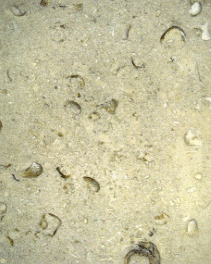Travis and Williamson Counties, Texas
Geologic Age:
Lower Cretaceous (about 100 million years ago)
Description:
The Cedar Park Limestone (Fredericksburg Group, Walnut Formation) is a fossiliferous limestone that interfingers with the Edwards Limestone north of Austin, Texas. The limestone contains ooids, microfossils, and finely crushed fossil debris. It is a distinctive 1.1-meter (4-ft.) thick layer of shelly limestone, which contains numerous cavities that are fossil molds of the pelecypod (clams), e.g. Trigonia and Protocardia exana. The oyster (Exogyra texana) and the gastropod (Turritella) are also common.
General Description:
Used as a dimension stone in the building trade, this shelly layer is marketed as the "Cordova Shell". It has been used on interior and exterior walls of government and private buildings throughout the United States, especially in Texas. In the Youngblood Library, a 6 centimeter (2.5-inch) thick veneer has been used on the base of the circulation counter, as a frame for the crinoid, and on the walls of the hallway and entrance into the Library.
